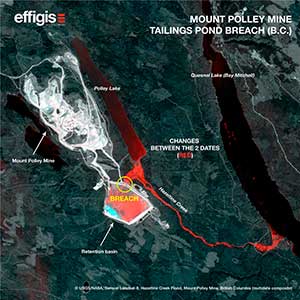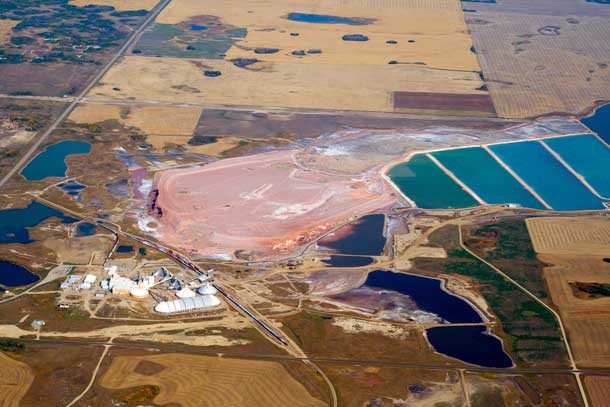One of the first lessons most of us learned from our mothers was “if you make a mess, clean it up”.
That advice is easy to abide by when picking up dirty socks but becomes much more complicated when dealing with tonnes of tailings from mine sites. Fortunately for both Saskatchewan miners and the environment, engineers and geoscientists around the province are hard at work to make the process easier.
What Are Tailings?
Tailings are the waste (often a liquid slurry) left over after the valuable parts of mineral ore have been extracted. It is distinct from the overburden, the hard rock that has to be chipped away to get to the ore. While the overburden is just regular rock that can be put back where it came from, tailings often contain contaminants that turn them into major environmental hazards.
Dealing with these hazards is a challenge that has tested the skills of geologists and engineers from around the world. Mark Liskowich, P.Geo., a former government mine inspector who has conducted several mine studies through SRK Consulting, notes that the challenge of tailings lies not just in the waste products themselves but in the surrounding environment.
“The challenges of tailings vary by commodity but in most cases the biggest issue is not so much the tailings themselves but the water associated with them. Tailings management has to be approached in a holistic way that considers solids, contaminated water and the water table that surrounds them,” Liskowich says.
Why are They Important?
The difficulty with tailings are that most mines produce a huge amount of them and typically keep them on site throughout the life of the mine, if not longer. Consequently when things go wrong with tailings, they often go very, very wrong.
One relatively recent incident in Canada that made headlines around the world was the massive Mount Polley spill in British Columbia in 2014. The dam containing the tailings for a copper and gold mine burst, releasing 10 million cubic metres of water and 4.5 million cubic metres of contaminated slurry into Polley Lake. In the end, the tailings pond was left virtually empty while Polley Lake was raised by 1.5 metres. Environmental consultants say the damage could last for years if not decades.
Closer to home, there is the ongoing story of the Gunnar uranium mine in the Uranium City area. The mine – which included both open pit and underground operations – operated from 1953 to 1963 and was abandoned in 1964 with very few, if any, site cleanup or environmental protection measures put in place.
The mine’s approach to dealing with its radioactive tailings are considered irresponsible by today’s standards. Approximately 4.4 million tonnes of tailings deposited during operation of the mine and mill were left open. The mine planned for these tailings to initially be dumped into Mudford Lake until the lake ultimately was filled. After that, the plan directed the tailings to a number of other areas near the mine with no consideration for how they might affect the environment.
Project CLEANS
Cleanup of Gunnar is in the hands of the Saskatchewan Research Council, which has spear-headed Project CLEANS (Cleanup of Abandoned Northern Sites) – the remediation of 37 abandoned mine and mill sites in northern Saskatchewan. Their challenge is formidable, with the price tag for total site cleanup estimated by the Saskatchewan Ministry of Economy at $268 million.
Key milestones for the Gunnar project came in 2015 and 2016 when the Canadian Nuclear Safety Commission approved SRC’s plans for remediating the site. SRC now has a contractor in place for the construction of the tailings cover to start in April 2017. In this case, the tailings cover will be composed of at least 0.6 metres of soil and aggregate.
Cameco Innovations
While uranium tailings in the past were handled haphazardly, modern uranium tailings management has come a long way thanks to innovative research at Cameco. Cameco pioneered the design and use of in-pit tailings management facilities. These engineered storage facilities are designed to protect the environment for thousands of years and are recognized as a best practice in tailings management around the world. Cameco maintains this type of facility at Key Lake and Rabbit Lake.
“This in-pit storage concept at Rabbit Lake was really a fantastic breakthrough and a turning point for uranium tailings storage in the mid-1970s. It remains a best practice throughout the industry,” Liskowich says.
A key feature of Cameco’s in-pit storage system is its dewatering technology, used to draw groundwater toward the in-pit tailings facilities, which ensures contaminants do not move into the surrounding environment. The water collected by these systems is treated to remove contaminants and then released to the environment. After operations have ceased, groundwater moves through a more permeable area that surrounds the tailings. This system ensures that groundwater flow through the tailings are limited and reduces the spread of contaminants from the tailings.
Potash Searches for Solutions
While the uranium industry has made headway in tailings management, the potash industry has faced hurdles.
The increasingly popular solution method of potash mining produces relatively little in the way of tailings thanks largely to its liquid-based extraction methods. Conventional potash mines on the other hand face a thorny waste management problem.
Most potash mines produce a waste stream of water-insoluble material and primarily water-soluble sodium chloride salts collectively known as fine tailings. These tailings are discarded from the mill in the form of salt brine that is 70 per cent solid and 30 per cent liquid. It naturally flows and cannot be successfully stacked as is done with mines’ coarse tailings.
Fine tailings have been stored separately in shallow engineered ponds, or cells, that take up a great deal of land and remain soft indefinitely, providing little opportunity for capping with soil and then vegetation.
In 1999, PotashCorp entered into an agreement with Saskatchewan’s Ministry of the Environment that allowed it to build a new fine tailings cell at its Lanigan operation, provided it did extensive research to find a more environmentally acceptable solution to fine tailings disposal.
PotashCorp has invested millions of dollars into a research effort that has had its share of disappointments. A number of methods that looked promising in the lab proved either uneconomic or logistically unfeasible in the field.
All was not lost, however. Through this exhaustive research on removing brine from fine tailings, it was discovered that the liquid brine could be removed on site, after fine tailings were in modified engineered tailings ponds that would allow free brine to drain from the fine tailings into brine storage ponds – essentially leaving the tailings high and dry.
The most promising approach to future fine tailings management appears to be a method in which the tailings are pumped to a containment cell and the brine is allowed to flow freely through a permeable barrier – a porous berm constructed at the downstream end of the cell. This brine is recovered and the remaining fine tailings consolidated into a solid form similar to what can be achieved by centrifuge.
If this method succeeds, the fine tailings that are left over will be solid enough to stack vertically, which conserves land and will be more easily capped and planted when the facility is ready to be decommissioned.
PotashCorp, in cooperation with another potash company, continues to work on the technology.
Pipe Flow Technology Centre
The potash industry’s struggles to deal with sludgy residue are mirrored by operations in the oil sands. In order to extract bitumen from mined oil sands, it is mixed with warm water. Once the bitumen has been removed, a tailings mixture of water, sand, silt, clay and residual bitumen is left over. This mixture is stored in tailings ponds where the majority of the solids settle to the bottom and the water is recycled through the bitumen extraction process.
The portion of tailings that does not quickly settle forms a layer in the middle of the pond. This mixture, called fluid fine tailings can take decades to form a solid, if left on its own. Industry researchers have developed a suite of tailings thickeners that help solidify the residue. However, the thickened tailings have the consistency of thick mud and thus, require different design techniques and equipment.
SRC’s Pipe Flow Technology Centre™ (PFTC) is aimed at researching how slurry pipelines behave and laying the foundation for developing pipelines that can effectively transport thickened tailings. SRC’s Pipe Flow Model is a tool that is used to help design slurry pipelines, making them more energy efficient, more reliable and reduce costs. To improve the model, there have been ongoing multi-party research projects over the years.
“The SRC Pipe Flow Model was developed over decades of research and is recently being improved through multi-client projects,” said Lesley McGilp, P.Eng., manager of SRC’s PFTC. “The most recent study will contribute to the development of a model that the mining industry can apply to systems involving laminar flows, including the transport of thickened tailings.”
The Work Continues
Although we have come a long way since the days of the Gunnar mine, incidents like the Mount Polley spill show that there is still much more to be done to tackle tailings. At SRC and other research facilities in Saskatchewan and around the world, the work continues.
“SRC is looking towards the sustainable management and remediation of mine tailings areas. It is promising to see that, within the last 50 years, the industry has moved from the mentality of ‘return it to the earth’ towards well-thought-out tailings storage areas to meet the environmental protection requirements and to support traditional activities near and through former mine sites,” says Christopher Reid, P. Eng., project manager for environmental remediation at SRC.
The time is ripe for new methods in tailings management, Liskowich adds.
“The in-pit system in uranium mines works great but it requires a used-up mine. Those are getting harder to come by as uranium companies keep digging to greater depths in the same spots. That means you instead have to look at the possibility of digging a pit just for tailings storage, and that gets expensive.”
But Liskowich is confident that solutions can be found.
“Engineers and geoscientists just need to go back to basics and think outside the box as they did back in the 1970s. I’m confident that with the right engineering focus and proper consideration for solids and liquids that the Mount Polleys of the world won’t occur.”


